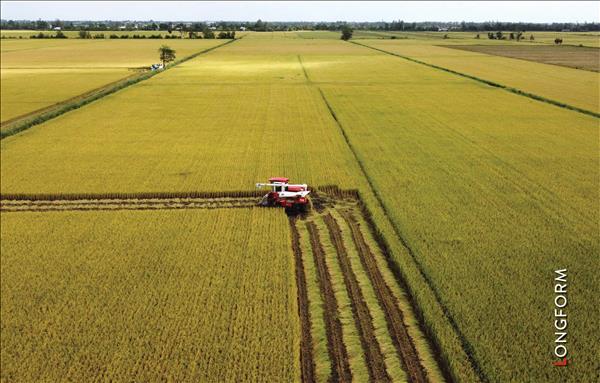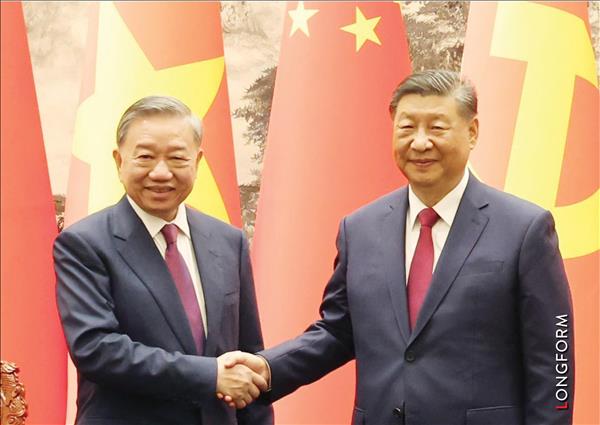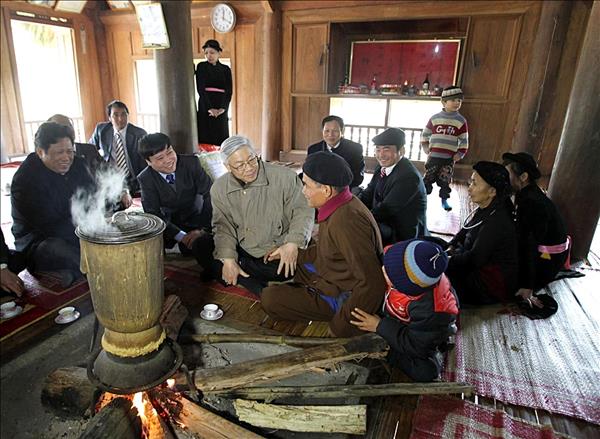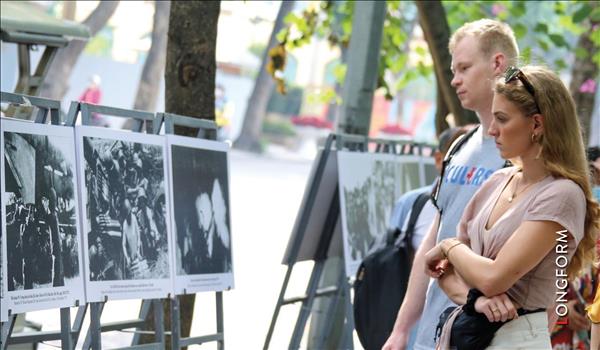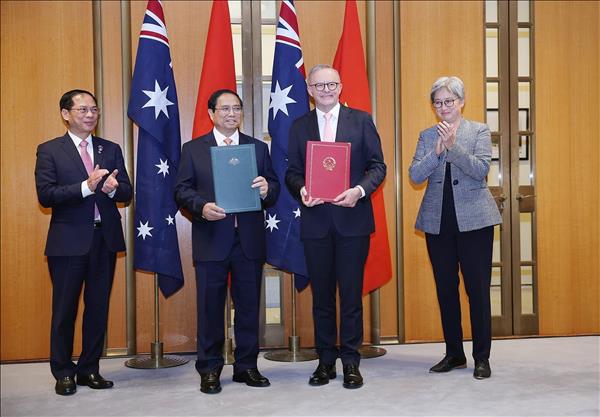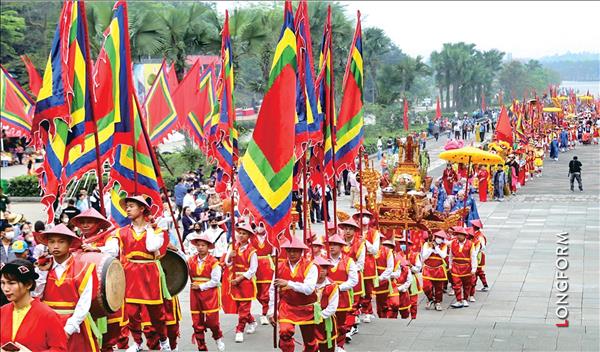Vietnam sovereignty over Hoang Sa Archipelago
The Socialist Republic of Vietnam rejects as completely unfounded, in fact and in law, China’s sovereignty claims over the Hoang Sa Archipelago (which China calls “the Xisha islands”, also known as the Paracel Islands) in the annexes to the letters dated May 22, 2014 and June 9, 2014 from the Chargé d’affaires a.i. of the Permanent Mission of the People’s Republic of China to the United Nations addressed to the Secretary-General of the United Nations as contained in documents A/68/887 and A/68/907 respectively. Vietnam affirms that the Chinese claims have no legal or historical foundation.
Historical documents are not in accord with China’s claims of sovereignty over the Hoang Sa Archipelago (Paracel Islands)
China has, in its recent communications, referred to some documents as historical evidence to assert the so-called “sovereignty” of China over the Hoang Sa Archipelago of Vietnam. However, these “documents” cannot be authenticated, lack accuracy and have been interpreted by China in an arbitrary fashion. The documents referred to by China do not by any means prove that China established sovereignty over the Hoang Sa Archipelago when this territory was terra nullius. Historical records, by contrast, show that China understood that its sovereignty did not extend to the Hoang Sa Archipelago.
For example, in the last decade of the 19th century when the ships Bellona and UmejiMaru sank in the Hoang Sa Archipelago and were looted by Chinese fishermen, the Chinese authorities of Guangdong Province of China argued that the Hoang Sa Archipelago was abandoned islands which did not belong to China. The archipelago neither was administratively attached to any district of Hainan of China nor fell under the responsibility of any Chinese authority. China, on these grounds, refused to take responsibility for the incident.
In contrast, Vietnam has publicly provided authentic historical materials proving that Vietnam established its sovereignty over the Hoang Sa Archipelago when the islands were terra nullius. Since at least the 17th century, the Nguyen dynasties of Vietnam organized activities to exploit resources on islands of the Hoang Sa Archipelago, undertook maritime measurements and recorded navigation routes to ensure the safety of navigation by foreign vessels through the waters of Hoang Sa Archipelago. These activities were well recorded in official documents issued by the Vietnamese dynasties, which are still archived in Vietnam.
After France and Vietnam had signed the Protectorate Treaties of March 15, 1874 and June 6, 1884 respectively, France, on behalf of Vietnam, continuously exercised Vietnam’s sovereignty over the Hoang Sa archipelago and protested against China’s infringements. France conducted many activities to exercise sovereignty over the Hoang Sa Archipelago, including building and operating lighthouses and meteorological stations, establishing administrative delegations responsible for the archipelago attached to Thua Thien Province (Annam), and granting birth certificates to Vietnamese citizens born in the archipelago. In 1909, the exploratory mission conducted by Commander Li Zhun of Guangdong of China violated the sovereignty well established by Vietnam over the Hoang Sa Archipelago and effectively exercised by France on behalf of Vietnam. France, on behalf of Vietnam, protested against China’s intrusions upon the Hoang Sa Archipelago and reaffirmed that sovereignty over the Hoang Sa Archipelago was well established by Vietnam. In response to China’s claims over the Hoang Sa Archipelago, France requested China to resolve the issue by international arbitration (French Note Verbal dated February 18, 1937 addressed to China), but China refused.
In 1946, the Republic of China under Chiang Kai-shek, taking advantage of the situation at the end of the Second World War, illegally intruded upon Phu Lam (Woody) Island of the Hoang Sa Archipelago. In 1947, France protested against this illegal intrusion and requested that the two parties negotiate and settle the issue through third party adjudication, which the Republic of China again refused. The Chiang Kai-shek regime later withdrew from Woody Island.
The Socialist Republic of Vietnam rejects as completely unfounded, in fact and in law, China’s sovereignty claims over the Hoang Sa Archipelago (which China calls “the Xisha islands”, also known as the Paracel Islands) in the annexes to the letters dated May 22, 2014 and June 9, 2014 from the Chargé d’affaires a.i. of the Permanent Mission of the People’s Republic of China to the United Nations addressed to the Secretary-General of the United Nations as contained in documents A/68/887 and A/68/907 respectively. Vietnam affirms that the Chinese claims have no legal or historical foundation.
Historical documents are not in accord with China’s claims of sovereignty over the Hoang Sa Archipelago (Paracel Islands)
China has, in its recent communications, referred to some documents as historical evidence to assert the so-called “sovereignty” of China over the Hoang Sa Archipelago of Vietnam. However, these “documents” cannot be authenticated, lack accuracy and have been interpreted by China in an arbitrary fashion. The documents referred to by China do not by any means prove that China established sovereignty over the Hoang Sa Archipelago when this territory was terra nullius. Historical records, by contrast, show that China understood that its sovereignty did not extend to the Hoang Sa Archipelago.
For example, in the last decade of the 19th century when the ships Bellona and UmejiMaru sank in the Hoang Sa Archipelago and were looted by Chinese fishermen, the Chinese authorities of Guangdong Province of China argued that the Hoang Sa Archipelago was abandoned islands which did not belong to China. The archipelago neither was administratively attached to any district of Hainan of China nor fell under the responsibility of any Chinese authority. China, on these grounds, refused to take responsibility for the incident.
In contrast, Vietnam has publicly provided authentic historical materials proving that Vietnam established its sovereignty over the Hoang Sa Archipelago when the islands were terra nullius. Since at least the 17th century, the Nguyen dynasties of Vietnam organized activities to exploit resources on islands of the Hoang Sa Archipelago, undertook maritime measurements and recorded navigation routes to ensure the safety of navigation by foreign vessels through the waters of Hoang Sa Archipelago. These activities were well recorded in official documents issued by the Vietnamese dynasties, which are still archived in Vietnam.
After France and Vietnam had signed the Protectorate Treaties of March 15, 1874 and June 6, 1884 respectively, France, on behalf of Vietnam, continuously exercised Vietnam’s sovereignty over the Hoang Sa archipelago and protested against China’s infringements. France conducted many activities to exercise sovereignty over the Hoang Sa Archipelago, including building and operating lighthouses and meteorological stations, establishing administrative delegations responsible for the archipelago attached to Thua Thien Province (Annam), and granting birth certificates to Vietnamese citizens born in the archipelago. In 1909, the exploratory mission conducted by Commander Li Zhun of Guangdong of China violated the sovereignty well established by Vietnam over the Hoang Sa Archipelago and effectively exercised by France on behalf of Vietnam. France, on behalf of Vietnam, protested against China’s intrusions upon the Hoang Sa Archipelago and reaffirmed that sovereignty over the Hoang Sa Archipelago was well established by Vietnam. In response to China’s claims over the Hoang Sa Archipelago, France requested China to resolve the issue by international arbitration (French Note Verbal dated February 18, 1937 addressed to China), but China refused.
In 1946, the Republic of China under Chiang Kai-shek, taking advantage of the situation at the end of the Second World War, illegally intruded upon Phu Lam (Woody) Island of the Hoang Sa Archipelago. In 1947, France protested against this illegal intrusion and requested that the two parties negotiate and settle the issue through third party adjudication, which the Republic of China again refused. The Chiang Kai-shek regime later withdrew from Woody Island.
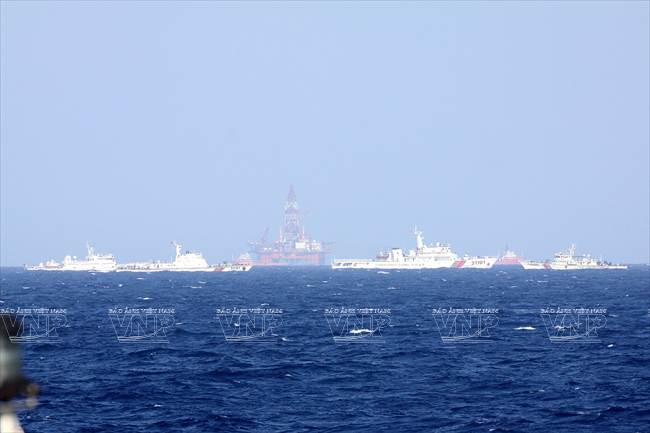
China illegally installs its Haiyang-Shiyou 981 in Vietnam’s exclusive economic zone and continental shelf
meets with strong protest of Vietnam and international community. Photo: Cong Dinh – Huu Trung – VNA
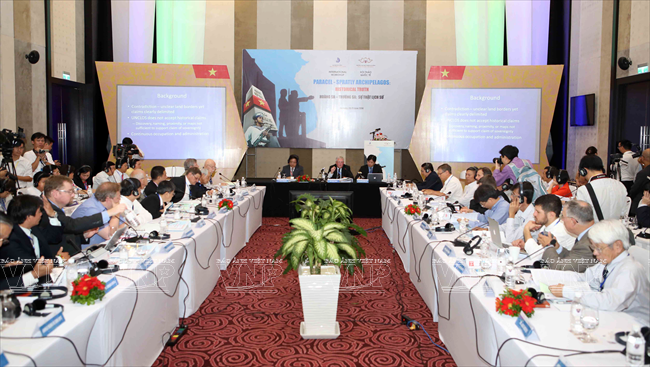
Nearly 100 domestic and foreign delegates, scholars and researchers from the US, Russia, France, Belgium,
Canada, Australia, India, Japan, South Korea, the Philippines participated in an internal conference
entitled “Hoang Sa-Truong Sa: Historical Truth” held in Da Nang. Photo: VNA
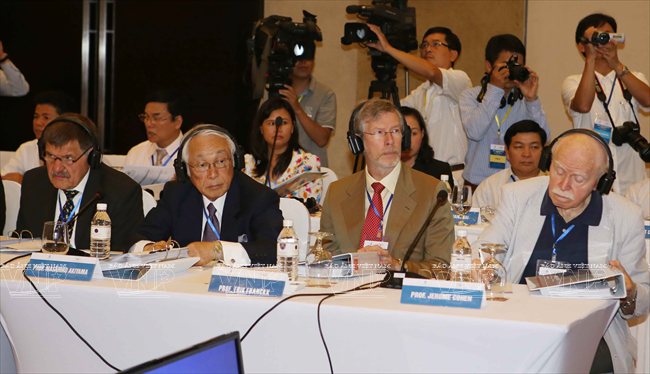
Foreign scholars participate in an internal conference entitled
“Hoang Sa-Truong Sa: Historical Truth” held in Da Nang. Photo: Tran Le Lam – VNA
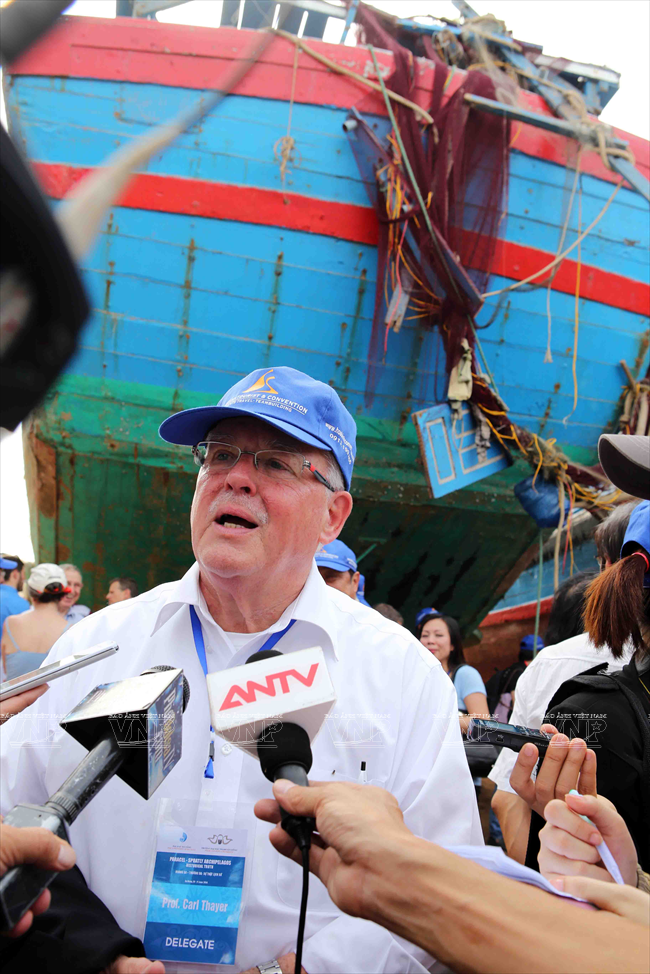
Prof. Carl Thayer gives an interview to reporters when he and a delegation inspect fishing boat DNa 90152 of Vietnam
which was sunk by a Chinese boat in Vietnam’s waters. Photo: Tran Le Lam/ VNA
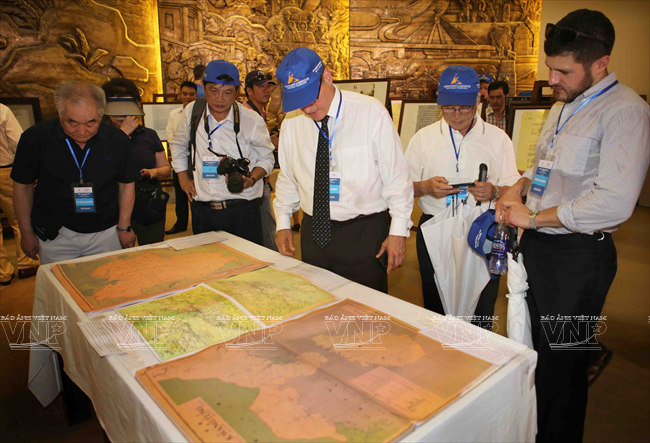
Domestic and foreign delegates visit a photo exhibition on Hoang Sa – Truong Sa held in Da Nang. Photo: Tran Le Lam/VNA
International conferences did not transfer the Hoang Sa archipelago to China
Before and after the end of the Second World War, the issue of sovereignty over the Hoang Sa archipelago was put on the agenda of a number of international conferences. The Cairo Conference held between November 22 – 26 1943, with the attendance of U.S. President Franklin D. Roosevelt, British Prime Minister Winston Churchill and Republic of China President Chiang Kai-shek, adopted the Cairo Communiqué aimed at eliminating Japanese administration over all Asia-Pacific islands seized by Japan since the First World War in 1914 and returning to China Chinese territories under Japanese occupation, including Manju, Taiwan and Penghu. Chiang Kai-shek who represented China at the Conference said nothing about the Hoang Sa and Truong Sa Archipelagoes.
The Potsdam Conference from 17 July to 2 August 1945 with the attendance of the leaders of the U.S., Great Britain and China issued the Potsdam Declaration reaffirming the Cairo Communiqué. Chiang Kai-shek, the representative of China at the Conference, again made no mention whatsoever of the Hoang Sa and Truong Sa (Spratly) Archipelagoes.
The San Francisco Peace Conference on September 4 – 8, 1951 was attended by representatives of 51 countries, including Vietnam as a member of the French Union. The Prime Minister of the State of Vietnam Tran Van Huu participated in the conference as Head of the Vietnamese Delegation. The Conference addressed the issue of devolution of a number of territories in the Asia Pacific region. At the Conference, the Head of Delegation of the Soviet Union, Mr. Andrei A. Gromyko, put forwards a proposal on behalf of China containing 13 items, among which was Japan’s recognition of the sovereignty of the People’s Republic of China over some islands in the East Sea (South China Sea), including the Hoang Sa archipelago. With 46 votes against, 3 votes in favour and 2 abstentions, the Conference rejected the proposal by the Delegation of the Soviet Union.
Immediately after that vote, on September 7, 1951, addressing the Conference, the Head of the Vietnamese Delegation Mr. Tran Van Huu reaffirmed Vietnam’s long standing sovereignty over the Hoang Sa and Truong Sa Archipelagoes. None of the 51 participating countries protested against that confirmation by the Vietnamese Delegation of Vietnam’s sovereignty over these Archipelagoes.
The Geneva Conference in 1954 on the restoration of peace in Indochina stated that the parties concerned would respect the independence and territorial integrity of Vietnam, which included the Hoang Sa and Truong Sa Archipelagoes then under the administration of French and Vietnamese forces. Having been a participant at the Geneva Conference, China is well aware of this fact and must respect the international instruments adopted at the Conference.
Article 1 of the Paris Agreement in 1973 clearly stated that all countries must respect the independence and territorial integrity of Vietnam. At that time, the Hoang Sa and Truong Sa Archipelagoes were under the administration of the Republic of Vietnam and constituted an integral part of Vietnamese territory.
In January 1974, China used military force to occupy the entire Hoang Sa Archipelago. The Governments of the Republic of Vietnam and the Provisional Revolutionary Government of South Vietnam issued statements to express their position and protest against China’s action. The Government of the Republic of Vietnam requested the United Nations Security Council to hold an urgent meeting on China’s use of force. Under the international law of territorial acquisition, the use of force to occupy a territory cannot create territorial title.
China violated the principle of refraining from the threat or use of force under international law and therefore could not establish sovereignty over the Hoang Sa Archipelago.
China illegally invaded the Hoang Sa Archipelago twice. Taking advantage of the withdrawal of France from Vietnam, in 1956 China invaded and occupied the eastern part of the Hoang Sa Archipelago. This was the first ever standing occupation of China anywhere in the Hoang Sa Archipelago which elicited strong protests from the Republic of Vietnam. In 1959, an attempt to land on the western part of the archipelago made by Chinese soldiers disguised as fishermen was smashed by the forces of the Republic of Vietnam. Eighty-two Chinese “fishermen” were captured. Both these invasions occurred after the sovereignty of Vietnam over the Hoang Sa and Truong Sa Archipelagoes had been reaffirmed, without any protest, at the above-mentioned international conferences. In 1974, taking advantage of the war in Vietnam, China attacked and seized control over the Hoang Sa Archipelago from the Government of the Republic of Vietnam. This was the first time ever that China obtained full occupation of the Hoang Sa Archipelago by force.
Under international law, the use of force to occupy the territory of another sovereign state is null and void and can never be the basis for a claim of sovereignty. Vietnam’s sovereignty over the Hoang Sa Archipelago therefore continues and is not displaced by China’s occupation by force.
The Memorandum of China on May 12, 1988, an official document of the Chinese Ministry of Foreign Affairs, also clearly asserted the principle of international law that “aggression cannot award sovereignty” over a territory. No country in the world recognizes China as sovereign over the Hoang Sa Archipelago.
Before and after the end of the Second World War, the issue of sovereignty over the Hoang Sa archipelago was put on the agenda of a number of international conferences. The Cairo Conference held between November 22 – 26 1943, with the attendance of U.S. President Franklin D. Roosevelt, British Prime Minister Winston Churchill and Republic of China President Chiang Kai-shek, adopted the Cairo Communiqué aimed at eliminating Japanese administration over all Asia-Pacific islands seized by Japan since the First World War in 1914 and returning to China Chinese territories under Japanese occupation, including Manju, Taiwan and Penghu. Chiang Kai-shek who represented China at the Conference said nothing about the Hoang Sa and Truong Sa Archipelagoes.
The Potsdam Conference from 17 July to 2 August 1945 with the attendance of the leaders of the U.S., Great Britain and China issued the Potsdam Declaration reaffirming the Cairo Communiqué. Chiang Kai-shek, the representative of China at the Conference, again made no mention whatsoever of the Hoang Sa and Truong Sa (Spratly) Archipelagoes.
The San Francisco Peace Conference on September 4 – 8, 1951 was attended by representatives of 51 countries, including Vietnam as a member of the French Union. The Prime Minister of the State of Vietnam Tran Van Huu participated in the conference as Head of the Vietnamese Delegation. The Conference addressed the issue of devolution of a number of territories in the Asia Pacific region. At the Conference, the Head of Delegation of the Soviet Union, Mr. Andrei A. Gromyko, put forwards a proposal on behalf of China containing 13 items, among which was Japan’s recognition of the sovereignty of the People’s Republic of China over some islands in the East Sea (South China Sea), including the Hoang Sa archipelago. With 46 votes against, 3 votes in favour and 2 abstentions, the Conference rejected the proposal by the Delegation of the Soviet Union.
Immediately after that vote, on September 7, 1951, addressing the Conference, the Head of the Vietnamese Delegation Mr. Tran Van Huu reaffirmed Vietnam’s long standing sovereignty over the Hoang Sa and Truong Sa Archipelagoes. None of the 51 participating countries protested against that confirmation by the Vietnamese Delegation of Vietnam’s sovereignty over these Archipelagoes.
The Geneva Conference in 1954 on the restoration of peace in Indochina stated that the parties concerned would respect the independence and territorial integrity of Vietnam, which included the Hoang Sa and Truong Sa Archipelagoes then under the administration of French and Vietnamese forces. Having been a participant at the Geneva Conference, China is well aware of this fact and must respect the international instruments adopted at the Conference.
Article 1 of the Paris Agreement in 1973 clearly stated that all countries must respect the independence and territorial integrity of Vietnam. At that time, the Hoang Sa and Truong Sa Archipelagoes were under the administration of the Republic of Vietnam and constituted an integral part of Vietnamese territory.
In January 1974, China used military force to occupy the entire Hoang Sa Archipelago. The Governments of the Republic of Vietnam and the Provisional Revolutionary Government of South Vietnam issued statements to express their position and protest against China’s action. The Government of the Republic of Vietnam requested the United Nations Security Council to hold an urgent meeting on China’s use of force. Under the international law of territorial acquisition, the use of force to occupy a territory cannot create territorial title.
China violated the principle of refraining from the threat or use of force under international law and therefore could not establish sovereignty over the Hoang Sa Archipelago.
China illegally invaded the Hoang Sa Archipelago twice. Taking advantage of the withdrawal of France from Vietnam, in 1956 China invaded and occupied the eastern part of the Hoang Sa Archipelago. This was the first ever standing occupation of China anywhere in the Hoang Sa Archipelago which elicited strong protests from the Republic of Vietnam. In 1959, an attempt to land on the western part of the archipelago made by Chinese soldiers disguised as fishermen was smashed by the forces of the Republic of Vietnam. Eighty-two Chinese “fishermen” were captured. Both these invasions occurred after the sovereignty of Vietnam over the Hoang Sa and Truong Sa Archipelagoes had been reaffirmed, without any protest, at the above-mentioned international conferences. In 1974, taking advantage of the war in Vietnam, China attacked and seized control over the Hoang Sa Archipelago from the Government of the Republic of Vietnam. This was the first time ever that China obtained full occupation of the Hoang Sa Archipelago by force.
Under international law, the use of force to occupy the territory of another sovereign state is null and void and can never be the basis for a claim of sovereignty. Vietnam’s sovereignty over the Hoang Sa Archipelago therefore continues and is not displaced by China’s occupation by force.
The Memorandum of China on May 12, 1988, an official document of the Chinese Ministry of Foreign Affairs, also clearly asserted the principle of international law that “aggression cannot award sovereignty” over a territory. No country in the world recognizes China as sovereign over the Hoang Sa Archipelago.
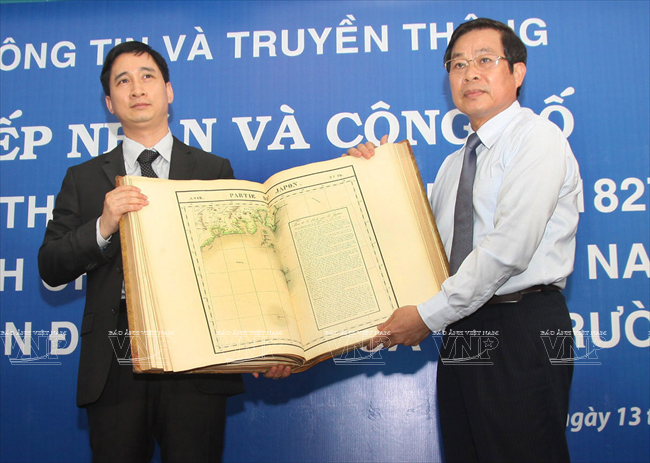
Minister of Information and Communications Nguyen Bac Son receives an Atlas, Bruxelles – 1827, affirming Vietnam’s sovereignty
over Truong Sa and Hoang Sa Archipelagoes. Photo: Hoang Hung/VNA
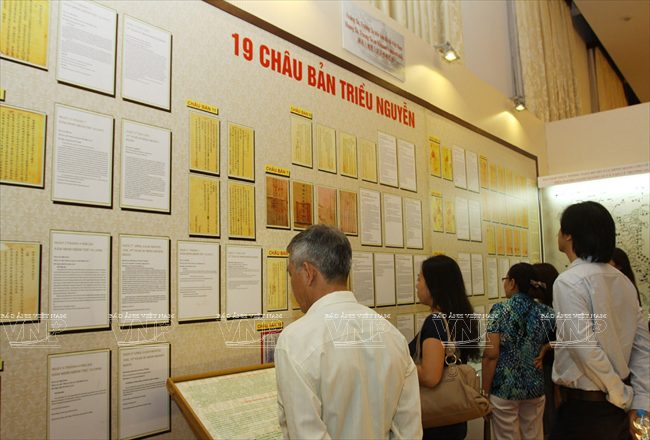
Administrative documents of the Nguyen Dynasty clearly show Vietnam’s sovereignty over
Truong Sa and Hoang Sa Archipelagos. Photo: Phuong Vy/VNA

The map “Dai Nam nhat thong toan do” drawn in 1834 under the reign of King Minh Mang, shows Hoang Sa
and Truong Sa in Chinese. Photo: Nguyen Dung/VNA
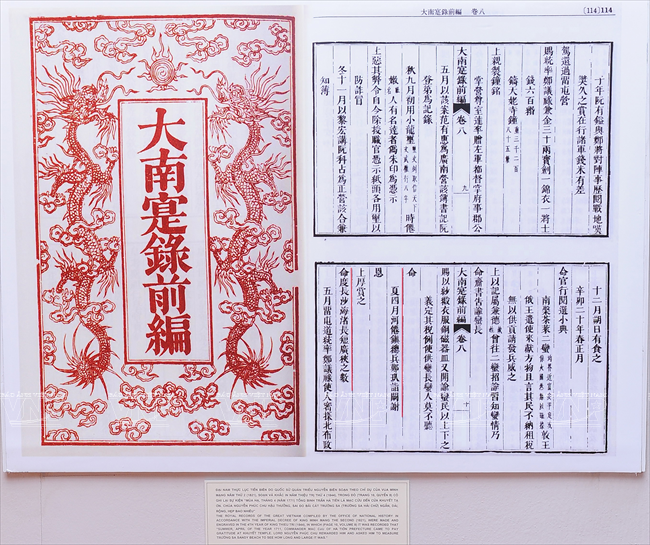
In the Dai Nam Thuc Luc (Chronicle of Greater Vietnam) compiled in the Nguyen Dynasty according to the edict of King Minh Mang,
the 2nd year (1821), carved and printed in the 4th Thieu Tri Year (1844), page 10, book 8, records the event that in April, Summer in 1771,
Division Commander of Ha Tien Town Mac Cuu was assigned by Lord Nguyen Phuc Chu the task of measuring Truong Sa Beach.
Vietnam has never recognised China’s sovereignty over the Hoang Sa archipelago
China has deliberately distorted and misinterpreted history when it refers to the letter signed by late Prime Minister Pham Van Dong in 1958 and other materials and publications published in Vietnam before 1975 in attempts to support its claims over the Hoang Sa Archipelago. The letter made no mention at all of sovereignty over the Hoang Sa and Truong Sa Archipelagoes. The letter concerned maritime entitlements, not territorial issues. In fact, the conclusions that China would draw today from the letter are contradicted by China’s own statements, including statement by Chinese Leader Deng Xiao Ping himself.
In September 1975, 17 years after the release of the letter by the late Prime Minister Pham Van Dong, Chinese Leader Deng Xiao Ping told Vietnamese Leader Le Duan in Beijing that “China has sufficient materials to prove that the Xisha islands (Hoang Sa) and Nansha islands (Truong Sa) have been part of China’s territory since long ago. However, in line with the principle of friendly consultation to resolve differences, the two countries will discuss with each other to address this issue later”. Deng Xiao Ping’s statement was well noted in China’s Ministry of Foreign Affairs Memorandum dated 12 May 1988 and reflects China’s understanding that sovereignty was not settled in favour of China by any previous statement or agreement. Vietnam requests that China respect this historical fact and seriously engage in negotiations with Vietnam in respect of the Hoang Sa Archipelago.
By VNA/VNP
danghuyen

